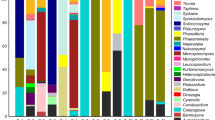Summary
0948 02
-
1.
A new myxobacterium was isolated from a variety of soils which were collected in widely separated areas in different climate zones. The organism appears to be a common member of the soil microflora.
-
2.
The new species belongs to the family Sorangiaceae. A new genus had to be established for it. The name Nannocystis exedens is proposed.
-
3.
The vegetative cells of N. exedens are cylindrical, fat rods with blunt, rounded ends. In the central parts of the swarm and in older cultures the cells become short ovoid, cube shaped, or even spherical. The myxospores are spherical and optically refractile.
-
4.
The fruiting bodies are solitary cysts with a firm wall. They are oval or spherical in shape and very variable in size: the smallest specimens measured 6×3.5 μm and less, the largest ones about 110×40 μm.
-
5.
When N. exedens is grown on poor media the agar within the swarm area becomes corroded in a peculiar fashion: large caverns, tunnels, deep holes, and furrows arise. The pattern is possibly due to agar decomposition.
-
6.
The new organism requires a complex organic N-source. Gelatine is liquefied, milk casein hydrolyzed. Cells of Sarcina lutea are almost completely lysed, yeast cells are attacked, but their walls cannot be broken down. Cellulose and starch are not decomposed. All strains are catalase-positive.
Similar content being viewed by others
References
Conn, H. J., Jennison, M. W., Weeks, O. B.: Routine tests for the identification of bacteria. In: Manual of Microbiological Methods, p. 158. New York: McGraw-Hill 1957.
Drozdowicz, A.: Investigations on cellulose decomposition by myxobacteria from the genus Sporocytophaga. Acta microbiol. pol. 10, 255–270 (1961).
Dworkin, M., Voelz, H.: The formation and germination of microcysts in Myxococcus xanthus. J. gen. Microbiol. 28, 81–85 (1962).
Fåhraeus, G.: Studies in the cellulose decomposition by Cytophaga. Symb. bot. Upsalien. 9, 1–128 (1947).
Gran, H. H.: Studien über Meeresbakterien. II. Über die Hydrolyse des Agar-Agars durch ein neues Enzym, die Gelase. Bergens Museums Aarbog, 1902, No. 2.
Imshenetsky, A. A.: (The nitrifying bacteria and myxobacteria.) Mikrobiologiya 14, 177–190 (1945).
—: Mikrobiologie der Cellulose. Berlin: Akademie-Verlag 1959. Russian original: Moscow 1953.
—, Solntseva, L.: (On cellulose decomposing myxobacteria.) Mikrobiologiya 6, 3–15 (1937).
Pronina, N. J.: (A description of new species and varieties of cellulose decomposing myxobacteria.) Mikrobiologiya 31, 470–477 (1962).
Reichenbach, H.: Untersuchungen an Archangium violaceum. Ein Beitrag zur Kenntnis der Myxobakterien. Arch. Mikrobiol. 52, 376–403 (1965).
Singh, B. N.: Myxobacteria in soils and composts; their distribution, number and lytic action on bacteria. J. gen. Microbiol. 1, 1–10 (1947).
Stanier, R. Y.: Studies on marine agar-digesting bacteria. J. Bact. 42, 527–558 (1941).
Veldkamp, H.: A study of two marine agar-decomposing, facultatively anaerobic myxobacteria. J. gen. Microbiol. 26, 331–342 (1961).
Author information
Authors and Affiliations
Rights and permissions
About this article
Cite this article
Reichenbach, H. Nannocystis exedens gen. nov., spec. nov., a new myxobacterium of the family Sorangiaceae . Archiv. Mikrobiol. 70, 119–138 (1970). https://doi.org/10.1007/BF00412203
Received:
Issue Date:
DOI: https://doi.org/10.1007/BF00412203




